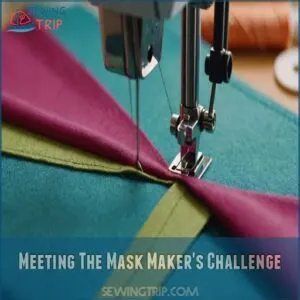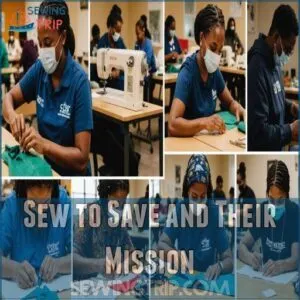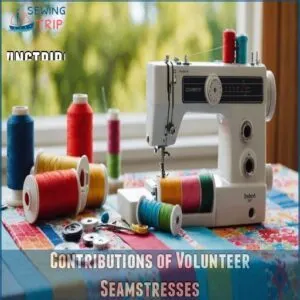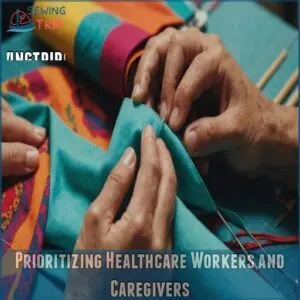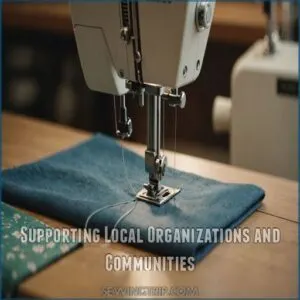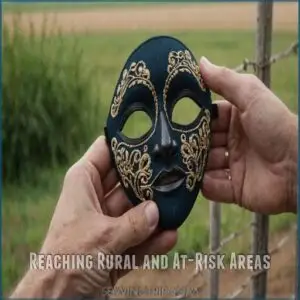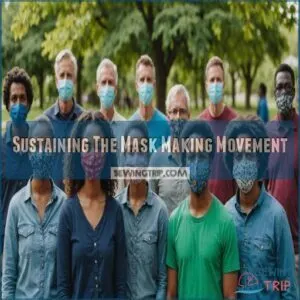This site is supported by our readers. We may earn a commission, at no cost to you, if you purchase through links.

These modern-day artists work their magic in home studios and community centers, creating everything from medical-grade face coverings to whimsical costume pieces.
They’re turning cottons, silks, and innovative materials into personalized works of art that do more than just cover – they empower and protect.
Behind every stitch lies a story of creativity, care, and connection to fellow mask-seekers making their mark on the world.
Table Of Contents
Key Takeaways
Here are 4 key takeaways from the article:
- You’re joining a global community of crafters when you make masks, transforming simple materials into protective gear and artistic expressions.
- You’ll find everyday heroes responding to urgent needs, overcoming supply shortages, and distributing masks to healthcare workers and vulnerable communities.
- You can contribute to the mask-making movement by sewing, donating supplies, or supporting local initiatives that prioritize healthcare workers and underserved areas.
- You’ll need to choose the right fabrics (like tightly-woven cotton), wash masks regularly, and experiment with patterns to ensure comfort and effectiveness.
Meeting The Mask Maker’s Challenge
You’ll start your mask-making journey by picking out your fabric stash and gathering your sewing supplies, just like our creative sewers who turned their homes into mini mask factories.
When your sewing machine starts humming and the fabric starts flowing, you’re not just making masks – you’re joining a community of everyday heroes who’ve turned their crafting skills into a lifeline for others.
Responding to The Call for Masks
Sewing machines whirred to life as local heroes answered the urgent call for masks.
When the pandemic hit, skilled sewers like our featured maskmaker transformed their fabric stashes into lifesaving protection, often turning to online resources like unique handmade masks for inspiration.
You’ll find these community champions crafting custom masks for healthcare workers, family members, and vulnerable neighbors.
Their motivation? Simple: protecting those they love while putting their sewing talents to work for the greater good.
Overcoming Supply Shortages and Equipment Issues
Supply-chain struggles tested even seasoned maskmakers, but creative solutions emerged everywhere.
When elastic became scarce, resourceful sewers raided their grandmothers’ antique machines and reached out to friends.
Constant mask production pushed sewing machines to their limits, requiring extra maintenance.
Yet through community support and innovative thinking, maskmakers adapted – swapping materials, sharing supplies, and keeping their machines humming to meet the growing demand.
Community Driven Mask Making Efforts
You’ll find ordinary heroes at work in neighborhoods across America, where skilled sewers transform colorful fabrics into life-saving face masks for healthcare workers and community members in need.
With groups like Sew to Save leading the charge, these dedicated volunteers work tirelessly from dawn to dusk, turning their dining room tables into mask-making stations and proving that even the smallest stitches can make the biggest difference.
Sew to Save and Their Mission
A remarkable grassroots initiative, Sew to Save emerged when Lisa Schneiderman channeled the spirit of tikkun olam to address the critical PPE shortage.
Starting with just a vision and determination, they’ve built an impressive network that’s transforming the face of community service.
Their efforts were further supported by accessing high-quality surgical mask supplies.
- Secured 1,000 surgical-grade masks from China
- Developed doctor-approved mask patterns with filter pockets
- Created sewtosave.org for volunteer coordination
- Expanded services beyond healthcare to first responders
- Partnered with Oregon Food Bank and Jewish Family Services
Contributions of Volunteer Seamstresses
Volunteer seamstresses have become the backbone of mask-making initiatives across communities.
At Cedar Sinai Park alone, generous contributors like Sharon Flock crafted over 800 masks, working tirelessly from dawn till dusk, using techniques like how to sewing mask to provide a comfortable and customizable fit.
Let’s look at the remarkable efforts of these community heroes:
| Volunteer | Masks Made | Hours/Day | Recipients | Special Touch |
|---|---|---|---|---|
| Sharon Flock | 800+ | 17.5 | Family/CSP | Themed designs |
| Beth Campbell | Various | 12+ | Healthcare | Olson pattern |
| Ronna Morton | Various | 10+ | Public | Pocket style |
| David Saltzman | 1,000 | – | CSP | Standard type |
| Sew to Save Group | 900+ | Varied | Multiple | Filter pocket |
Distribution of Masks to Those in Need
You’ll find mask makers working tirelessly to get their colorful creations to healthcare workers, seniors, and community groups who need them most.
From local hospitals to rural communities, these dedicated volunteers make sure their handmade masks reach those who can’t access or afford protective gear.
Many offer their masks completely free of charge.
Prioritizing Healthcare Workers and Caregivers
Healthcare heroes stand at the frontlines, and mask makers have stepped up to protect them by crafting masks with tightly woven fabrics like cotton or batik, which can be learned more about in this face mask tutorial.
Working tirelessly, these community champions prioritize getting masks to medical professionals and caregivers first.
Here’s what drives their dedication:
- The raw emotion of seeing exhausted nurses finally receiving proper protection
- The relief in a caregiver’s voice when handed fresh masks
- The quiet strength of ICU staff knowing their community has their back
Looking at how communities mobilize to support healthcare workers, it’s clear that every stitch matters.
Supporting Local Organizations and Communities
The important flow of mask donations reached far beyond immediate circles, touching local organizations like the School District of Belleville, public libraries, and senior centers.
You’ll find dedicated makers like Sharon Flock working tirelessly, crafting themed masks from dawn till dusk.
Through platforms like Sew to Save, with its network of 600 sewers and 60 drivers, these community lifelines distribute over 1,000 masks weekly to hospitals, clinics, and food banks.
Reaching Rural and At-Risk Areas
Responding to urgent mask needs, passionate makers have expanded their reach beyond urban centers.
You’ll find dedicated volunteers driving hours to deliver essential protection to underserved areas, where access to healthcare supplies is limited.
Here’s how communities are bridging the gap:
- Navajo Nation receiving targeted mask donations through organized drives
- Rural healthcare facilities getting priority shipments
- At-risk communities connecting with makers through online platforms
Sustaining The Mask Making Movement
You’ll discover how your sewing skills and extra fabric can make a real difference in your community, just like Sharon who’s transformed her crafting hobby into a lifeline for hundreds.
Whether you’re stitching masks for healthcare heroes or sharing supplies with fellow sewers, you’re not just making masks – you’re weaving together a network of care that keeps our communities safe.
Encouraging Community Involvement and Support
Making masks became more than just stitching fabric—it transformed into a movement of community heroes answering the call.
You’ll find countless ways to join this important effort, whether you’re a seasoned sewist or just starting out.
| How to Help | Impact Made |
|---|---|
| Donate fabric | Powers mask production |
| Share supplies | Keeps makers creating |
| Spread the word | Builds awareness |
| Offer deliveries | Reaches those in need |
| Join sewing groups | Creates community |
Researching and Addressing Local Needs
Finding your local community’s mask needs starts with picking up the phone and reaching out. You’ll get firsthand knowledge about who needs help most.
Consider supporting mask donation initiatives browse mask donation products to understand how you can contribute.
Contact nearby organizations to understand their specific requirements and current situation.
- Check with retirement homes and hospice facilities first
- Call local hospitals for their current PPE status
- Connect with community meal services
- Reach out to post offices and grocery stores
Promoting Collaboration and Resource Sharing
Seamstresses across communities have woven together powerful support networks, sharing not just supplies but knowledge.
You’ll find fabric donations flowing through local groups, while experienced makers mentor newcomers through virtual sewing workshops.
Many mask makers coordinate through social media to match resources with needs.
Whether you’re donating materials or sharing techniques, your contribution strengthens these important community bonds.
Frequently Asked Questions (FAQs)
What’s the point of the mask maker in Hollow Knight?
You’ll encounter the Mask Maker deep in Deepnest.
This mysterious character crafts masks that grant new abilities.
By seeking them out, you’ll gain powerful upgrades to enhance your journey through Hallownest’s treacherous caverns.
How to beat the mask maker Kena?
To beat Kena’s Mask Maker, dodge his acrobatic attacks and wait for openings.
Utilize your spirit companions for distractions.
Strike when he’s vulnerable after big moves.
Stay patient and learn his patterns for victory.
What fabrics work best for making effective masks?
Tight-woven cotton’s your go-to for homemade masks.
Mix in layers of silk or chiffon for extra filtration.
Avoid synthetic fabrics; they’re less breathable.
Remember, multiple layers are key.
Wash your fabric before sewing to prevent shrinkage surprises!
How often should cloth masks be washed?
Time flies when you’re staying safe!
Wash your cloth masks daily or after each use.
If you’re out and about frequently, aim for a good scrub every evening.
Keep those face shields fresh and effective!
What are the essential tools for mask making?
You’ll need sewing essentials: fabric scissors, pins, a sewing machine, and thread.
Don’t forget a pattern, tightly woven cotton fabric, and elastic or ties.
A wire for the nose bridge adds comfort.
Happy mask-making!
Can masks be made without a sewing machine?
Like the resourceful Odysseus crafting his raft, you can make masks without a sewing machine.
Hand-stitching works well, or try no-sew methods using fabric glue, staples, or folding techniques.
You’ve got options to protect yourself creatively.
Which mask patterns provide the most comfortable fit?
Comfort’s key when picking mask patterns.
Opt for adjustable nose wires and ear loops.
Pleated designs offer flexibility, while 3D or duckbill shapes create breathing space.
Experiment with different styles to find your perfect fit. It’s all about personal preference!
Conclusion
Like a tapestry woven with threads of compassion, the call of "maskmaker maskmaker make me a mask" echoes through our communities.
You’ve seen how everyday heroes stepped up, stitching protection and hope into every fold.
Their efforts remind us that small acts of kindness can shield millions.
As you go about your day, remember the power of your own two hands.
Whether you sew or support, you’re part of this global fabric of care.
Together, we’ve masked up and shown up for each other.

